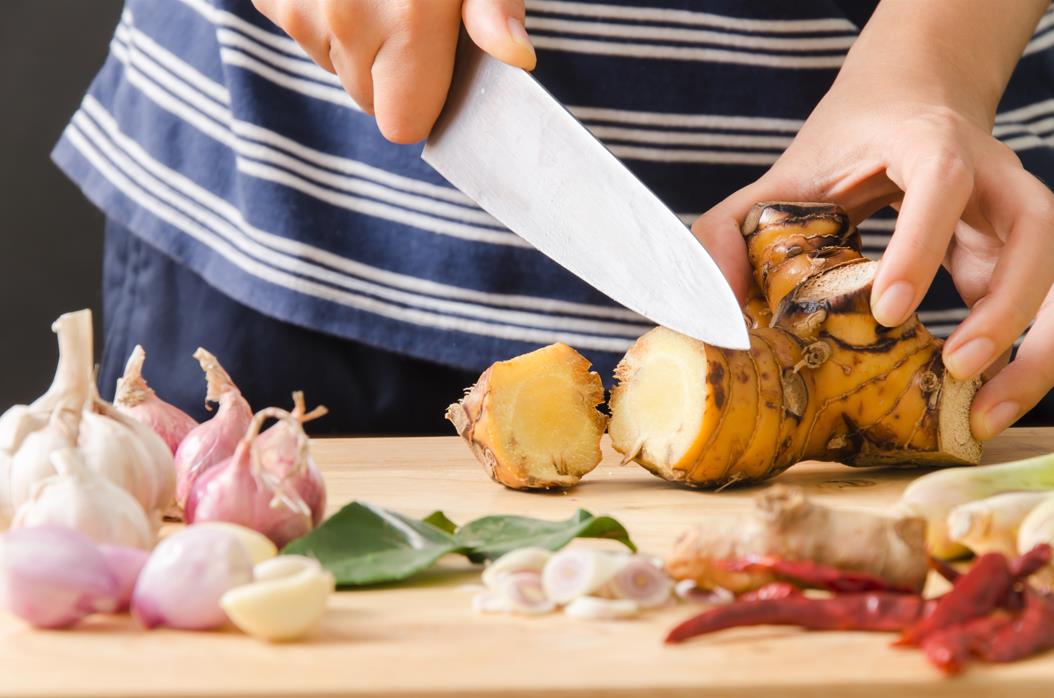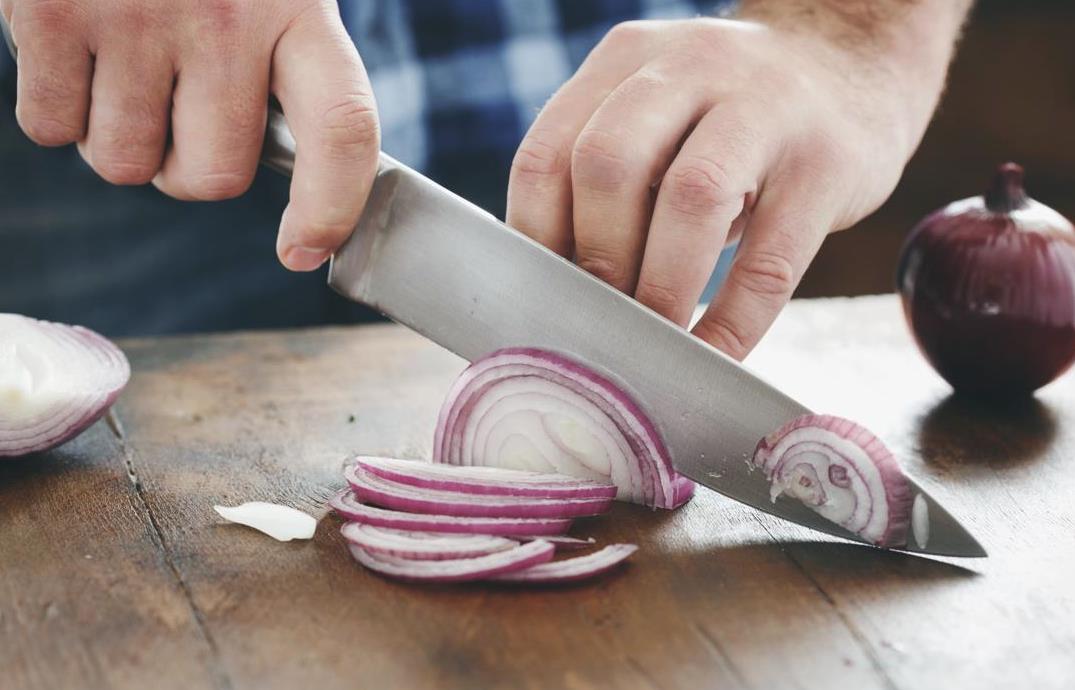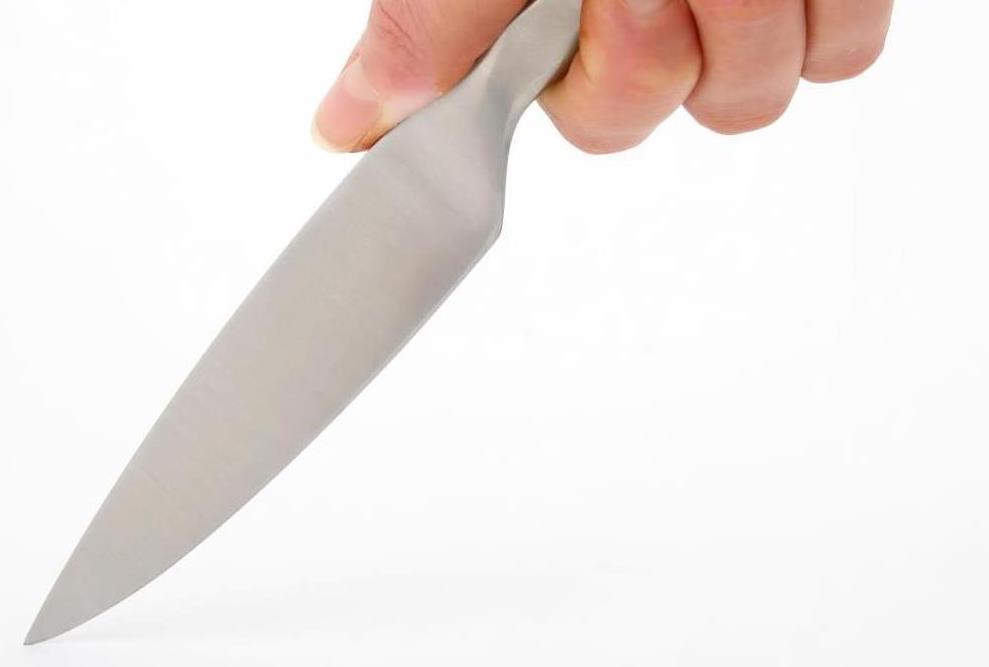One of the most effective tools to sharpen a kitchen knife is the sharpening stone. The purpose lies in the name – to sharpen knives and other tools. While there are different types of sharpening stones, one sticks out the most for being ideal for most: water stones.
Arguably, the best water stones come from Japan, and with their distinctive features, both professional and home cooks favor them. While natural Japanese water stones are hard to come by nowadays and more expensive than synthetic ones, they are still preferred over other types of water stones to give knives a razor-sharp cutting edge.
To understand what makes Japanese water stones unique and different from others, we first need to go over key details. This article will guide you on everything you need to know about Japanese water stones, from how to use one to choosing the ideal stone for your knives.
Table of contents
What is a whetstone?
Whetstones or water stones are a type of sharpening stones that require water as a lubricant to sharpen knives and other tools. They do this by removing metal from the blade, creating a brand new edge that’s aligned perfectly.
Over time, all knives get dull with use, but whetstones should not be utilized whenever your knife doesn’t perform at its best. Instead, hone your knives to realign the edges first. If it doesn’t produce the desired sharpness, it’s time to take your knife to a whetstone.
Whetstones aren’t only for sharpening, though. The low grit water stones are also used for fixing the chipped edges, a common problem seen, especially in carbon steel knives that are not used properly or hardened enough. If the edge chips, you can use a whetstone to create an entirely new edge.
Sharpening stone variations
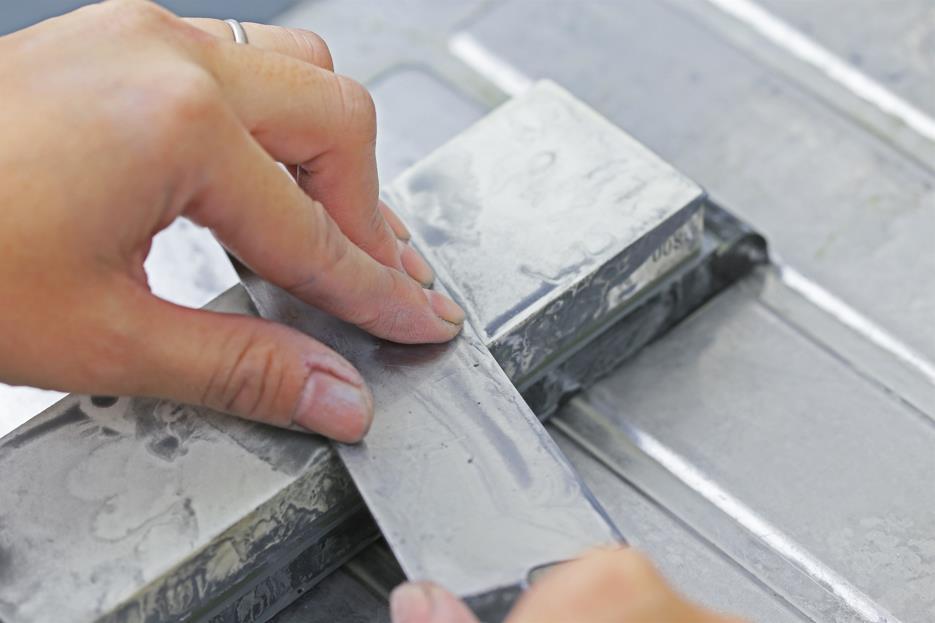
Although a whetstone’s purpose is pretty much the same as others – to sharpen knives – they aren’t the only stones used for this goal.
Aside from the grit and the actual size of the sharpening stone, which we can use to differentiate, the distinctions between them are also identified by the type of lubricant required. The different sharpening stones mainly include water stones, oil stones, and diamond stones.
Japanese water stones are like any other water stone but with minor tweaks that make them different. Let’s take a look at how these three different types of sharpening stones work to understand Japanese water stones better.
Oil stones
Oil stones are the most commonly used sharpening stones in the western world. These sharpening stones are made from aluminum oxide (India stone), novaculite, or silicon carbide.
Aluminum oxide and silicon carbide oil stones are artificially made. They are usually orange or brown and are tagged fine, medium, or coarse.
Novaculite oil stones are the most traditional one out of three. These oil stones are quarried in Arkansas and are processed to make what we call Arkansas stones. Like the other oil stones, they come in different grades based on their density. The grit doesn’t have a significant impact in the price, but the hard translucent and hard black Arkansas stones are the costliest.
Lastly, silicon carbide oil stones are generally used for the initial step of sharpening as they promote it in a faster way with their low grit. This wears down the edge faster and makes it ideal for fixing the chipped edges. However, the surface also wears down faster, requiring you to resurface it and replace it more quickly than others.
As the name suggests, oil stones need oil as a lubricant, regardless of what they’re made of. The use of oil can be a drawback to some as it creates more mess and is harder to clean. Nonetheless, oil stones are favored for their affordable pricing and grade varieties.
Diamond stones
These sharpening stones usually come with a metal plate with industrial diamonds attached. As diamond is a lot harder than steel, it doesn’t wear down and enables fast sharpening.
Diamond stones retain their flatness, making them ideal for continuously sharpening a whole set of kitchen knives. While they last long and offer fast sharpening, their cost is what makes people turn their heads away. It also takes an expert sharpener to use a diamond sharpener. These make diamond sharpening stones more for professional sharpeners.
Water stones
Like oil stones, water stones can be natural or synthetic. However, natural water stones are hard to come by and, therefore, more expensive. The synthetic varieties are usually made from aluminum oxide or silicon carbide. These are similar to oil stones but are much softer, providing faster sharpening.
The water stones sharpening blades quickly is beneficial, but it has some downsides. Over time, water stones lose their shape with use, requiring to be resurfaced as the surface becomes uneven from all the abrasion. This also happens with oil stones but at a slower rate.
Handpicked for you
True cutting power in the palm of your hand
Features of Japanese water stones
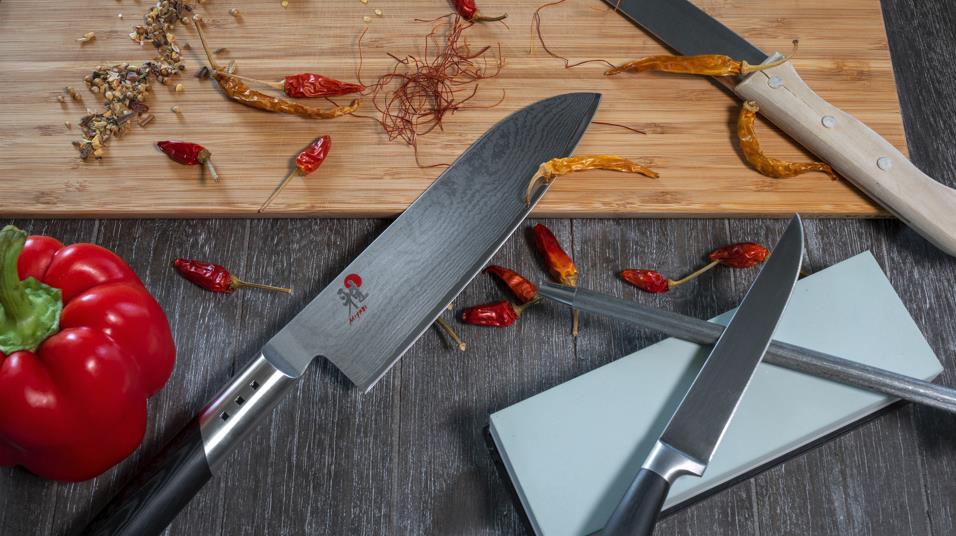
Now comes the Japanese water stones with their differences that make them unique.
Like the other water stones, Japanese water stones are soft but to a higher degree. As a result, stone filings also mix with water and form more slurry that contributes to the sharpening process and polishes the edge. This extra softness allows for faster sharpening, though it also wears down the whetstone quickly.
Although natural Japanese water stones are hard to come by nowadays, the synthetic ones made from aluminum oxide or silicon carbide give an exceptional finish to the blade. The difference between other synthetic water stones and Japanese varieties is that abrasive materials are loosely put together in them. Again, it promotes more slurry formation, becoming more abrasive.
Overall, Japanese water stones are softer, easier to clean, and facilitate quicker sharpening. However, these come with the downside of wearing down faster that requires you to replace them more often.
How to use a Japanese whetstone
There are two different ways to sharpen a kitchen knife, but the Japanese way is more appropriate considering we’re talking about Japanese water stones. We also included the western technique if you find the Japanese way not for you or incorporate both to get the best out of the two methods.
Before you begin
There are a few essentials to keep in mind before sharpening a knife, whether following the Japanese or western method. Since moving the blade on the sharpening stone will remove metal, you must keep the knife at a consistent angle throughout the process. This is vital to get a razor-sharp edge.
As for figuring out the angle, which depends on the knife you’re sharpening, the best way to do it is to have a feel for it. Place the knife on the sharpening stone and move the blade with minimal pressure while changing the angle between strokes. If it glides easily as if the edge is sitting straight on the stone without pushback, you got it! This is the most straightforward way of finding the right angle to sharpen your kitchen knife.
Additionally, the knife you bought might include the sharpening angle in the packaging. If you’re clueless, note that the correct angle to sharpen most Japanese knives is 15 to 20 degrees and 20 to 25 for western alternatives.
Preparing the Japanese water stone

Before using the water stone, it needs to be soaked in water completely to fill in the air pockets. The sharpening stone isn’t ready before this step. Simply submerge the Japanese water stone in water until the bubbles stop coming out. Be patient with this, as it can take anywhere from 10 minutes to an hour or so.
Japanese technique to sharpen a kitchen knife
The Japanese have a strict way of sharpening kitchen knives. They do this by starting from the heel and moving all the way to the tip gradually, keeping the blade parallel to the sharpening stone. For example, after the heel and a part of the body are sharpened, you continue from the middle to the tip. In this technique, you essentially partway complete the edge, and once a portion is finished, you move on to the next part.
Here is a step-by-step guide on how to sharpen a kitchen knife using a Japanese water stone.
- Wet the sharpening stone at the center. Just a drop of water is enough.
- Place the blade on the cutting board at the correct sharpening angle, covering from the heel to the midpoint of the body, and secure the position with your fingers.
- Move the blade forward and back. As retaining the same angle during the entire process is vital, push and pull the knife with your shoulders.
- In about five minutes into the sharpening (or when you see fit), flip and do it with the other side. If your knife is single-beveled, you don’t need to do this.
- After you sharpen a part of the blade, repeat the process for the rest of the cutting edge.
As the blade’s tip is hard to cover, you might need to sharpen it separately. See if the tip gets as sharp as the other parts to know whether you need to sharpen it individually or not.
Western technique to sharpen a kitchen knife
For novice sharpeners, the western technique is easier to go about even though we’re using Japanese whetstones. Rather than sharpening a part of the blade at once, you sharpen it entirely at once. Here is how to sharpen a blade following this technique.
- After the sharpening stone is ready, place the blade further on the whetstone.
- Rotate the knife to cover the entire edge as you pull the blade. The knife should be perpendicular to the sharpening stone as you get to the tip.
- Push the blade by moving it in the opposite direction to get to the exact point you started.
Because you’re sharpening the entire blade at once, this is easier for most. It’s also more time-efficient. Still, don’t be afraid to try and test out what works for you the best. If you have a large enough water stone at hand, you can keep the knife in the same position as you sharpen it.
Do’s and don’ts of knife sharpening
- Do keep the same angle throughout the sharpening.
- Don’t put pressure on the blade when pushing or pulling in the direction of the edge.
- Do start with a lower grit whetstone and move up to a higher grit to polish the blade and remove the burr from the edge.
- Don’t clean the stone before you’re finished with sharpening. The metal filings mixed with water help sharpen and polish the edge.
- Do listen to the sound the sharpening stone and the knife makes. It needs to be consistent during the entire process of sharpening.
- Don’t place the sharpening stone horizontal to cover the entire edge at once. There needs to be some travel to sharpen the edge. That’s why you need to rotate the blade as you pull and push it on the whetstone following the western sharpening technique.
Once you complete sharpening, the only thing left to do is test to see if your knife is sharp enough. The easiest way is to cut a piece of paper. If it cuts through easily without a hassle, congrats! It should be pretty sharp. Additionally, you can cut a tomato into very thin, transparent slices or a wet sponge to further test how sharp it really is.
How to choose a Japanese water stone?
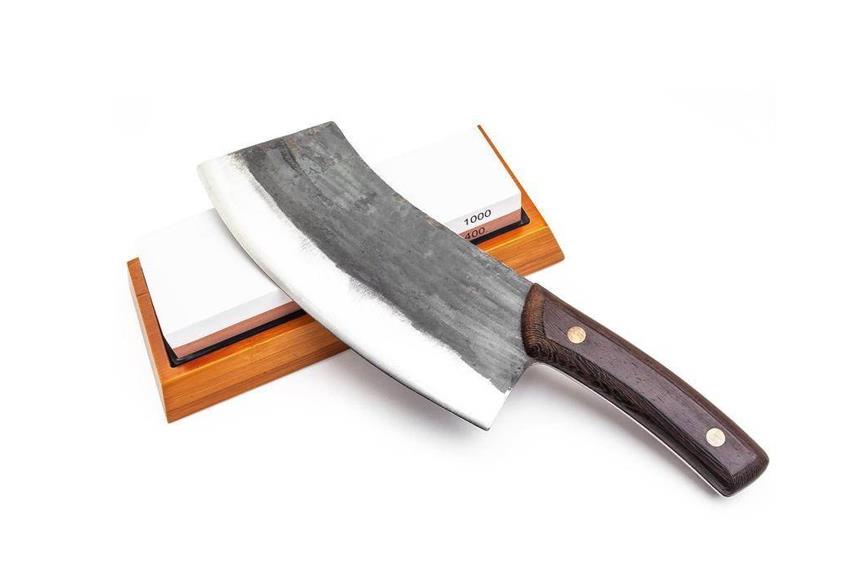
Whether Japanese or other, choosing a water stone is mainly about the grit range. Generally, you’ll need more than one Japanese stone to give your kitchen knives a razor-sharp cutting edge. That’s why many sharpening stones come with two sides with different grit ranges – one lower and the other higher.
Water stone grit ranges meaning
The sharpening stones with lower grit are more abrasive and are generally used to sharpen exceptionally dull blades or fix chipped edges. The ones with higher grit are for polishing and finishing the edges. These water stones are also known as finishing stones.
You can get Japanese water stones from 100 to 10,000 grit. Here is a short guide on picking the right Japanese whetstone.
Japanese water stones with less than 500 grit are more for repairing damaged edges. If you’re looking for a sharpening stone only to sharpen knives, you don’t really need anything less than 1,000 grit. Nevertheless, we recommend keeping a sharpening stone less than 1,000 grit just in case you get an exceptionally dull knife or accidents happen and you need to repair a chipped edge.
Starting with 1,000 to 1,500 grit to sharpen the edge and moving to 4,000 to 8,000 stones to refine the edge is enough for most kitchen knives. Many Japanese water stones will come with two sides: one with 1,000 and the other with 6,000 or 8,000 grit. Look for whetstones with two different grit ranges all-in-one and simply flip when you need to polish the edge to remove the burr after sharpening it.
In conclusion
Japanese whetstones are exceptional sharpening stones that sharpen kitchen knives fast and effectively. Despite being softer than other whetstones, they won’t wear down as quickly as some might think, considering how often you’ll sharpen knives.
Learn more about knives on HDMD Knives blog and shop for quality handmade kitchen knives.








